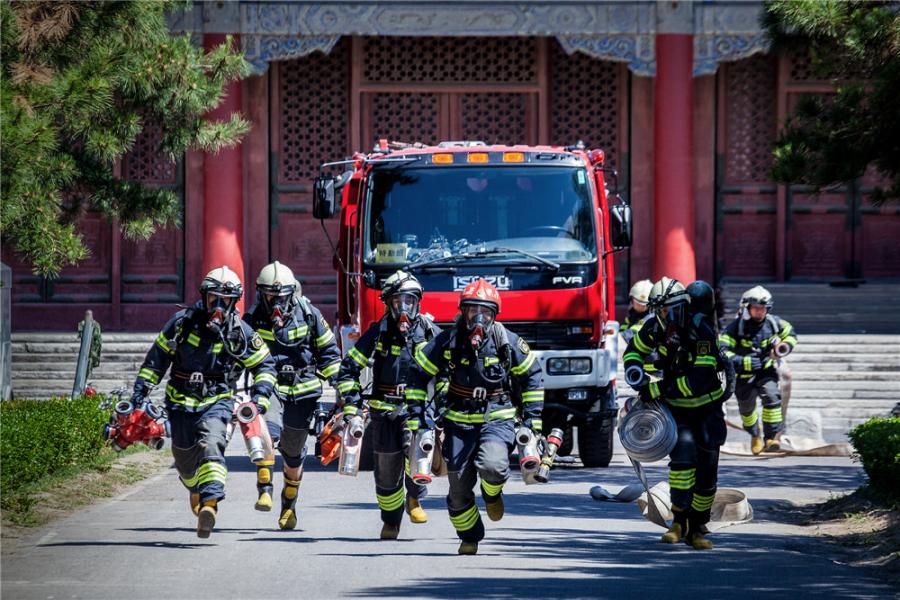
Drills are staged frequently at the Palace Museum in Beijing, where a team is stationed by the east gate to keep watch for fire in turn 24 hours a day. (Photo/CHINA DAILY)
50-strong prevention team keeps close watch on landmark
They are likely to go unnoticed by the multitude of visitors who pass the Donghuamen, or East Prosperity Gate, at Beijing's Palace Museum, also known as the Forbidden City.
A force of about 50 firefighters stationed in a courtyard by the east gate of the former imperial palace keeps watch around the clock for what is probably the biggest potential enemy of the world's largest wooden architectural complex: fire.
Du Yandong, 28, who leads a unit in the Tiananmen Fire Squadron, has lived in the Forbidden City for eight years.
On Sept. 3, he read that the 200-year-old National Museum of Brazil in Rio de Janeiro had been gutted by fire. More than 90 percent of the 20 million artifacts collected by one of the largest natural history and anthropology museums in the Americas was destroyed.
"I was dumbfounded and heartbroken," Du said. "I cannot imagine what would happen if the Palace Museum was on fire. Six hundred years of our history is here."
The group's job is to make sure there is no chance of such a disaster happening at the landmark.
The museum, used as the imperial palace from 1420 to 1911, covering 720,000 square meters, housed over 1.86 million cultural relics by 2016, according to the most recent inventory. The collection includes 42 percent of the registered national-level precious cultural relics.
Du's unit comprises six members manning a fire engine, with each in charge of a different firefighting job. They all rise at 6 am each day for practice. Running along the 3-kilometer moat at the Forbidden City is first, followed by more training in specific fields.
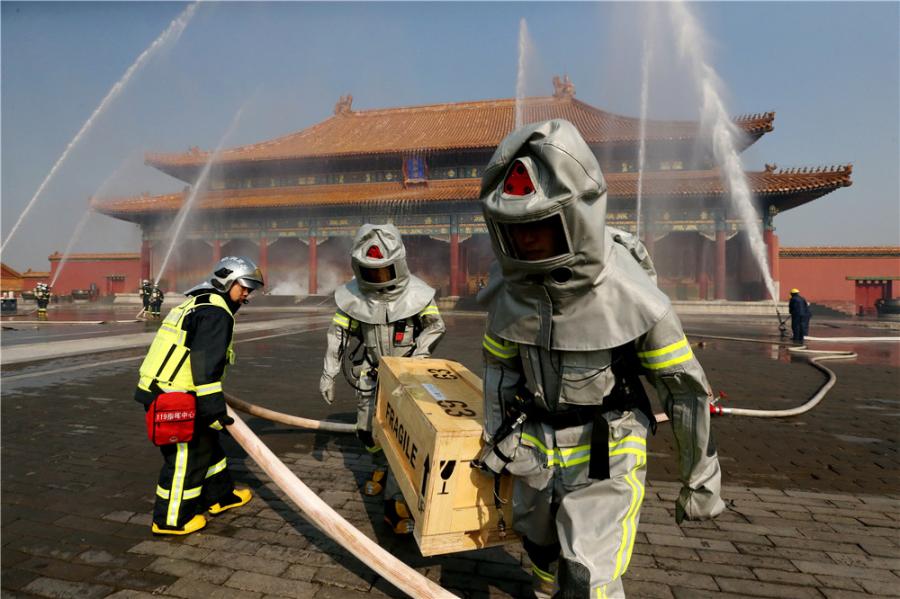
Drills are staged frequently at the Palace Museum in Beijing, where a team is stationed by the east gate to keep watch for fire in turn 24 hours a day. (Photo/CHINA DAILY)
Tests are held every week. Firefighters have to run more than 50 meters within 13 seconds carrying three rolls of 20-meter-long standpipe hoses and connecting them.
Strict practice is essential to remaining vigilant.
Firefighters stationed in residential areas may be called out to fires every day. However, since the Tiananmen Fire Squadron was set up in 1970, there have been no major fires within its 3.74-sq-km jurisdiction, which covers not only the Palace Museum but all of Tiananmen Square.
In 1987, the Palace of Great Brilliance (Jingyanggong) at the museum was hit by lightning and caught fire. The blaze was quickly put out before any damage was caused to cultural relics, although a small part of the roof was charred. After this, lightning conductors were installed on the roofs of all the buildings at the complex.
Du said: "Any fire at the Forbidden City, which is in the heart of Beijing, would have wider implications for the public than merely being just a cultural disaster. We have to take precautions against any latent danger."
Li Yang, 31, who has been with the squadron for 11 years, is in charge of the daily checks and rehearsals for emergencies.
He has walked through all the alleys in the Forbidden City to work out the best escape routes in the event of an emergency.
"Roads at this museum have various slopes, widths and are in different states of repair," Li said. "We are equipped with different vehicles to reach anywhere in the Forbidden City."
Li took an additional course compared with firefighters elsewhere to learn about cultural heritage and ancient architecture.
There are 8,728 "rooms"-any square space with four columns in it counts as one room in Chinese tradition-at the museum. Li had to learn about all of them.
"Different materials are used for the different palaces, which have their own construction techniques," he said. "And each hall houses different types of cultural relics."
He said water may not necessarily be best in fighting some blazes. For example, if some varieties of timber catch fire, foam will be used.
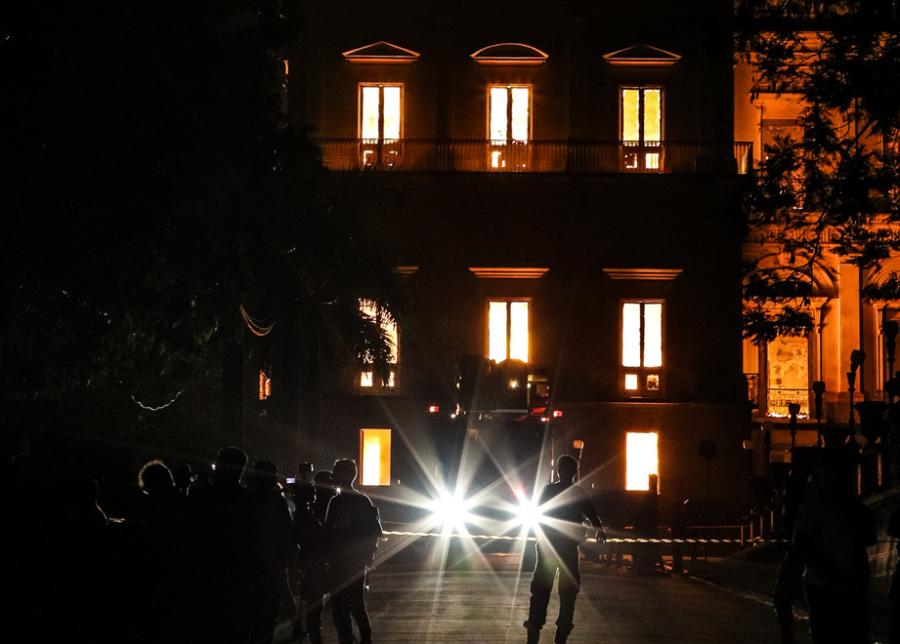
Fire sweeps through the National Museum of Brazil in Rio de Janeiro on Sept 3. (Photo/CHINA DAILY)
Asked how many fire hydrants there are in the Forbidden City, Du replied instantly, "167", adding, "I could not be more familiar with that number."
Each hydrant is checked four times a year to see if it is operating efficiently, as are the 3,000 extinguishers throughout the museum.
"And don't forget the 308 big copper water tanks," Du added.
The water tanks in the Forbidden City were used as "hydrants" in imperial times. Although the tanks in areas open to the public no longer hold water in case visitors fall in, those in the staff members' areas are still full.
"This will solve the problem of where to get the first bucket of water if a fire occurs," Du said.
Li said he had found many firewalls in the Forbidden City during his checks.
"These walls may look the same as others, but they are thicker," he said.
They can prevent fire spreading to neighboring courtyards. Ancient wisdom is still used in our security system today."
Landmarks protected
The squadron's jurisdiction includes many other national landmarks such as the Tian'anmen Rostrum and the Great Hall of the People, and this means that the firefighters sometimes face a heavier workload, especially during important conferences and festivals.
There is also the National Museum of China, which houses more than 1 million cultural relics, and has a floor area of 192,000-sq-m, one of the biggest in the world.
Du said members of a unit attached to the squadron live in the museum to keep a close eye on the building.
Twelve hydrants are positioned outside. "And 791 more are placed in the walls all over the building," he said. "For such a large construction with so many cultural relics, we need to pay special attention."
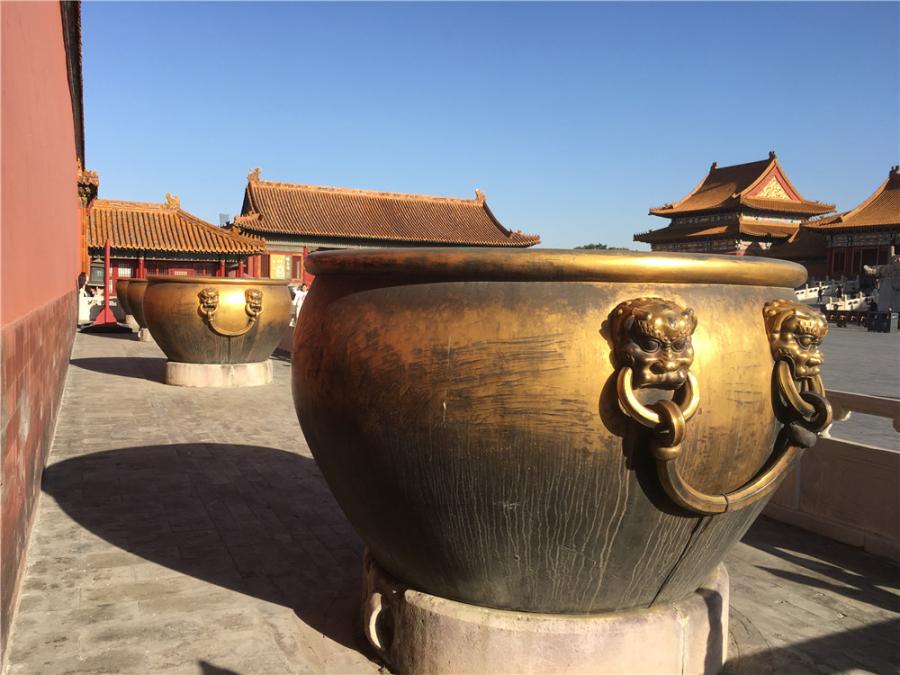
Water tanks at the museum, used as "hydrants" in imperial times, are still full in the staff members' areas. (Photo/CHINA DAILY)
Du and Li may be among the small number of those living in the palace as imperial families did, but their everyday lives are not that romantic.
A curfew is still imposed at the Forbidden City. Once night falls, all the gates leading to the outside are locked. They cannot be opened unless the squadron is called on to deal with an emergency outside.
"Everyone loves a vibrant night life," Li said. "But it's impossible for us." Du and Li said they often stood by East Prosperity Gate and peeped through the gap when they first came to the palace. This gate is near Wangfujing, one of Beijing's busiest commercial areas.
"There were many neon lights," Du said. "But they became blurred the farther I looked. "
For those staying overnight in the Forbidden City, it is not unusual to be frightened, thanks to the numerous folk legends that say the building is haunted by spirits.
However, both Du and Li said they had become used to their lives there. Many of their colleagues have transferred to other civilian work, but they chose to remain.
"This work still needs us," Li said. "It's a work of honor, which you cannot get somewhere else. The Palace Museum is my home now."
For each major exhibition at the museum, special patrols are added to check for fire risks in the galleries. "We can be the first ones to enjoy the exhibitions," Li said.
He added that they are not allowed to use an open flame to cook food at the museum, for safety reasons. "In Chinese cuisine, the dishes don't taste perfect when you can only fry food using an electric hob," he said.
Smoking banned
After the fire in Rio, a comprehensive examination was conducted immediately at the Palace Museum to check the fire alarms.
Shan Jixiang, director of the museum, knows that protecting the UNESCO World Heritage site from fire is not only the squadron's responsibility.
In 2013, one year after he took up his post, Shan decided to introduce a smoking ban throughout the complex. At the entrance security checks, lighters are not allowed to be taken inside.
"This work needs cooperation not only from tourists, but also our own staff," Shan said.
Museum employees who want to smoke must leave the premises and walk to designated areas near East Prosperity Gate and West Prosperity Gate.
Shan also said that every new employee at the museum has to be trained by squadron members on how to use fire extinguishers. Drills are held annually to practice salvaging relics in the event of a blaze.
However, he said improvements at the palace have brought new pressures.
For example, to renovate ancient buildings, and for other work, the use of a flame is sometimes unavoidable. Any worker using a flame has to have a certificate, and all fire-risk projects are halted during high winds.
Another challenge is posed by the lighting system in the exhibition halls.
Many tourists complained that the interiors of three major halls-the Hall of Supreme Harmony, the Hall of Central Harmony and the Hall of Preserving Harmony-were too dark, as power lines are not allowed in these buildings due to fire risks.
Shan decided to turn up the light in 2016.
All lights must be at least 1.5 meters away from the walls, and a special type of light is used to lower the heat. Metallic protective layers are added to cover the power lines.
"We have to take all necessary measures without making any errors," Shan said. "Because even a slight error means we lose everything."
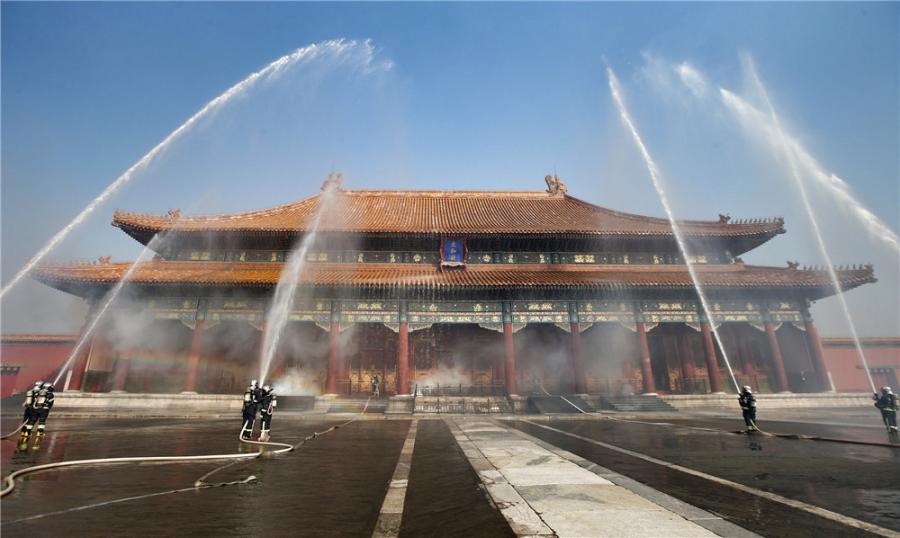
Drills are staged frequently at the Palace Museum in Beijing, where a team is stationed by the east gate to keep watch for fire in turn 24 hours a day. (Photo/CHINA DAILY)
Urgent situations
On Sept. 7, four days after the inferno in Rio, the State Administration of Cultural Heritage issued a notice urging museums nationwide to learn from the Brazilian blaze and improve awareness of protecting their collections.
The notice instructed museums to check their fire alarms, investigate whether their power lines are out of date, assign personnel to supervise fire prevention, and include this work in an overall evaluation system.
Devastating fires at Chinese museums are not common, the most recent major accident being a fire in 1994 at a museum in Jilin city, Northeast China's Jilin province. Two lives and thousands of cultural relics were lost.
However, a conference held by the State Administration of Cultural Heritage and the Ministry of Emergency Management on Sept 13 gave little room for optimism.
Liu Yuzhu, director of the administration, said: "Though big museums in the country generally do well in preventing fire, many smaller institutions lack the personnel to maintain and manage relevant facilities. Small fires are common.
"Ancient Chinese architecture is mainly constructed from wood and earth, which creates huge difficulties for protection," he said.
Liu added that 41 fires have occurred at key national-level cultural heritage sites since 2010.
A comprehensive survey carried out recently by the administration found that half of the 4,000 national-level key cultural heritage sites have potential fire hazards.
Liu also said that a wider investigation of 230,000 museums, heritage sites and cultural relics preservation institutions had found 21,000 safety breaches, with 41 percent of them related to fire prevention.
Huang Ming, deputy minister of emergency management, has called for a more complete operating system to be established at museums, adding that about 60 percent of fires are caused by faulty power supplies.
"Museum directors should check facilities more often. They should know their institutions like their own front yard."
He said new fire alarm technologies, based on digital platforms such as the internet of things, will be developed to keep a close eye on cultural heritage. "Fire alarms are the lifelines of all cultural relics," Huang said. "We have to keep a tight grip on safety at key sites."























